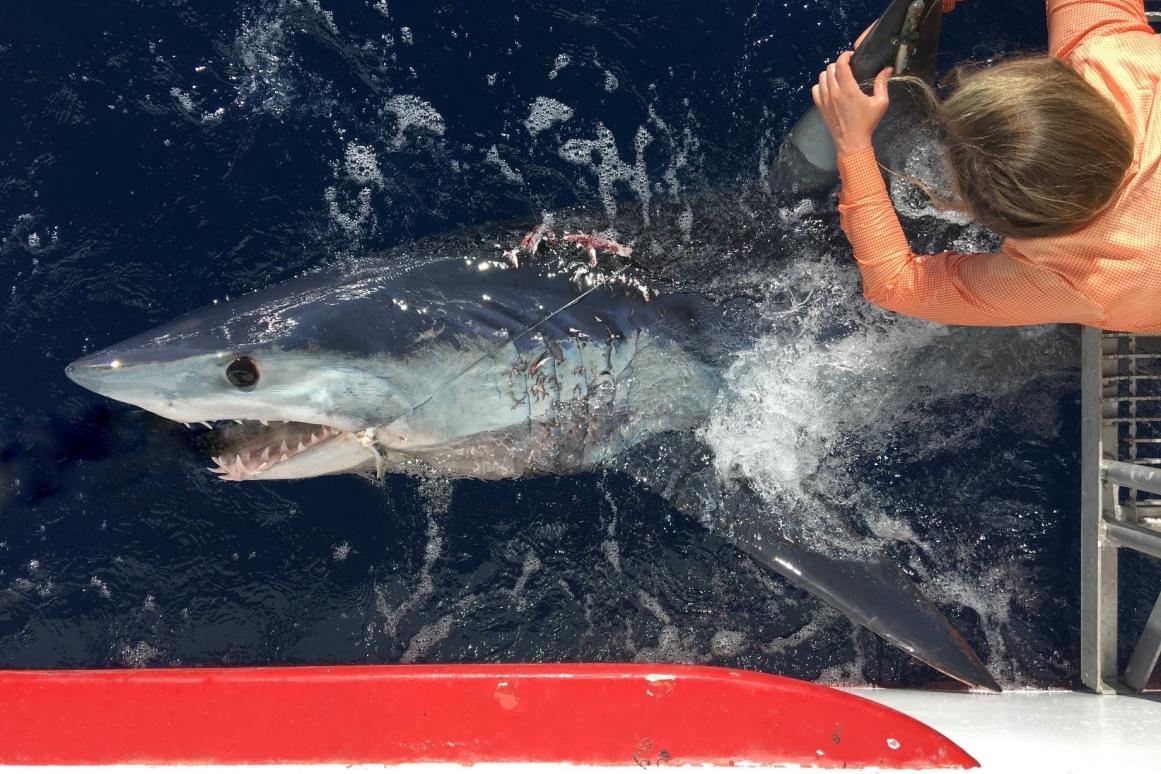Sportfish Center tags Mega Mako “Peggy” on Gulf Expedition

CORPUS CHRISTI, Texas — Researchers with the Center for Sportfish Science and Conservation (CSSC) tagged a mega Mako during one of their most recent expeditions off the coast of Texas. Citizen scientists are invited to help track this large female shark on her migratory journey as CSSC researchers learn more about the little-understood lives of Shortfin Makos in the Gulf of Mexico.
The CSSC and their shark tagging work will once again be featured on Discovery Channel’s popular “Shark Week.” Their episode, “The Lost Cage,” will air at 8 p.m. on Wednesday, July 26 on the Discovery Channel as part of Shark Week’s 30th anniversary season. You can watch the episode live with our Shark Week stars at Brewster Street Ice House, located at 1724 N Tancahua St., Corpus Christi. A special meet and greet with our shark researchers and shark-tagging demonstrations will begin at 6 p.m. There will be shark themed giveaways for kids and adults throughout the night. Admission is free and open to the public. The live episode begins at 8 p.m.
Weighing in at more than an estimated 1,000 pounds and over 11 feet, the female dubbed “Peggy Hughes” is one of the largest sharks that’s been satellite tagged by the Center for Sportfish Science and Conservation’s shark tagging program.
Named for Peggy Hughes, a friend of the Center for Sportfish Science and Conservation, avid outdoorswoman and strong supporter of marine and wildlife conservation from San Antonio, Texas, “Peggy” the shark has already pinged dozens of times and has been recorded swimming for hundreds of miles in an area off the coast of Houston and Louisiana.
“Peggy Hughes is quite an amazing shark,” said Dr. Greg Stunz, HRI Chair for Fisheries and Ocean Health and Director of the Center for Sportfish Science and Conservation. “Makos are well known to be highly migratory and one of fastest fish in the ocean, often making great leaps from the water. Makos show up in great numbers in our region in the fall and winter, but we have little information on where they go or when they leave.”
Peggy was tagged during a research expedition 120 miles offshore aboard the Scat Cat by a team of CSSC, with the help of Jupiter, Florida fisherman William Fay. Amazingly, Peggy was caught on 200-pound test monofilament line that she could have easily bitten through, and she was tagged after an hour-long fight on rod and reel.
Doctoral candidate Kesley Gibson tagged the shark. Researchers typically tag sharks after wrangling them boatside to attach the satellite tag to their dorsal fin. But because the Scat Cat is larger fishing vessel, Gibson tagged Peggy the Mako by climbing down the side of the boat onto a man overboard platform.
“It was the first time I’ve laid down on top of a shark to tag it, and she was twice as big as me. Up close, these sharks are gorgeous, but they’re powerful too. If she’d have decided at any point she didn’t want the tag we’d be done,” Gibson said.
The CSSC runs a number of tagging programs to monitor shark populations in the Gulf of Mexico to help fill information gaps about their lives in the Gulf. Working with fishermen, the CSSC has tagged more than 4,100 sharks along the Texas coast over the past six years. They’ve also deployed 18 special satellite tags that allow for the real-time tracking of Tiger, Mako and Hammerhead sharks.
Peggy is an especially interesting addition to CSSC’s tagging program due to both her size and her sex. Not much is known about the lives of Makos in the Gulf of Mexico. A pelagic, highly-migratory species, their speed and lengthy migration paths make them hard to study. Scientists speculate the sharks may overwinter in our region of the Gulf to breed based on the extensive and fresh mating scars often seen on females, Stunz said, but because smaller sharks are unusual it’s unlikely females have their young — called “pups” — here.
In her dissertation research, Gibson is examining the importance of artificial reefs in the Gulf of Mexico as shark habitat, and will be tagging additional Makos to look at how their migratory patterns relate to artificial reef placement and how they may be using the structures as habitat. These manmade reefs attract diverse communities of marine life, from coral colonies to the mighty Mako, and CSSC research has shown that they may add real productivity to the Gulf.
Researchers have already made exciting finds with a previously tagged Mako shark, “Harvey Weil,” who made a sudden, directed migration to the Caribbean in the late spring and early summer and then returned to the location he’d been tagged the previous fall, Stunz said.
“It will be interesting to see if ‘Peggy Hughes’ does the same thing,” Stunz said. “She is headed that way now and off the coast of Louisiana near the Mississippi Canyon. “
You can follow Peggy and many more of the sharks tagged by the Center for Sportfish Science and Conservation on their website or by downloading the Shark Tracker app for iOS and Android.
